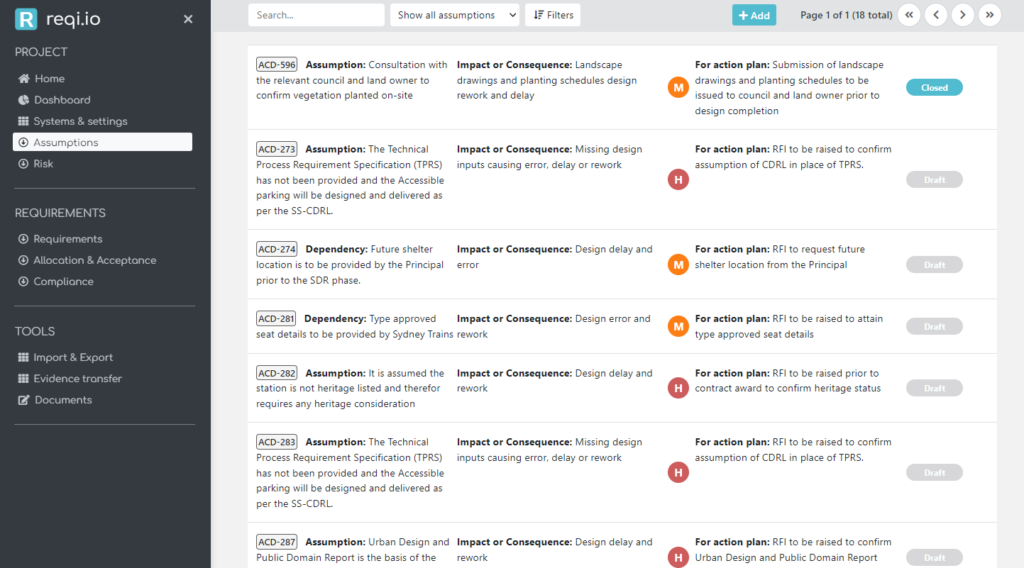An Assumptions, Constraints, and Dependency (ACD) register is a vital tool used in project management and systems engineering. It serves as a documented record to track, manage, and communicate crucial information regarding the assumptions, constraints, and dependencies that can significantly impact a project’s planning, execution, and outcomes. In this section, we will delve into the details of each component within an ACD register and discuss their significance.
Table of Contents
- Assumptions
- Constraints
- Dependencies
- The Importance of an ACD Register
- Frequently Asked Questions
- What are project assumptions and constraints?
- Can you provide examples of project assumptions and constraints?
- How do assumptions and constraints impact project management?
- What is an assumption and constraint analysis?
- Why is it important to analyze assumptions and constraints?
- What are critical assumptions and constraints?
- Can you provide examples of project charter assumptions and constraints?
- What are some examples of assumptions and constraints in construction projects?
- What are dependencies in project management?
- What are the types of dependencies in project management?
- Why is it important to identify and manage dependencies in a project?
- How do you capture and document dependencies?
- What is the impact of dependencies on project scheduling?
- How can project managers mitigate risks associated with dependencies?
Assumptions
Assumptions are statements or conditions that are treated as true for the purpose of planning a project or making decisions. They may not be verified or proven but are considered reasonable based on the available information at the time of assessment. Assumptions play a crucial role in project management as they help teams establish a baseline for decision-making. It is important to document assumptions to ensure transparency and facilitate tracking throughout the project’s lifecycle.
For example, in a software development project, an assumption could be that the development team will have access to the necessary hardware and software resources needed for testing. This assumption forms the basis of various decisions made during the planning and execution phases of the project.
Documenting assumptions in an ACD register allows project managers and stakeholders to have a clear understanding of the underlying assumptions driving the project. It enables better risk management, as any changes or challenges related to assumptions can be identified, communicated, and addressed in a timely manner.
Constraints
Constraints refer to factors or limitations that can impact a project’s scope, schedule, or resources. These are typically external factors that project managers and teams must work within and adapt to. Constraints can vary widely, including budgetary restrictions, regulatory requirements, resource availability, time limitations, and technological limitations.
When documenting constraints in an ACD register, it is crucial to clearly identify and communicate the specific constraints that apply to the project. For instance, if a project has a fixed budget, it becomes a significant constraint that needs to be considered in all decision-making processes.
Understanding and managing constraints is vital for effective project planning and successful project delivery. By documenting constraints in an ACD register, project managers can ensure that all stakeholders are aware of the limitations and can plan and allocate resources accordingly.
Dependencies
Dependencies are relationships between tasks or activities within a project. They indicate that the completion of one task is reliant on the completion of another. Identifying and managing dependencies is crucial for efficient project sequencing, scheduling, and resource allocation.
Dependencies can be categorized into four types:
- Mandatory dependencies: These dependencies are inherent and non-negotiable. The completion of a specific task is mandatory before another task can start, often due to technical or logical requirements.
- Discretionary dependencies: These dependencies arise due to best practices or preferences. They are not strictly necessary but are followed for efficiency or effectiveness.
- External dependencies: These dependencies involve tasks or activities that rely on external factors, such as third-party deliveries or regulatory approvals. They often introduce uncertainties into the project schedule.
- Internal dependencies: These dependencies occur within the same project and involve tasks or activities that are interrelated.
By capturing dependencies in an ACD register, project teams can visualize the critical path and determine which tasks are dependent on others. This provides clarity and helps identify potential bottlenecks or areas that may require specific attention to ensure timely project completion.
The Importance of an ACD Register
The ACD register serves as a central repository of key information related to assumptions, constraints, and dependencies. Its importance lies in facilitating effective decision-making, risk management, and stakeholder communication throughout the project’s lifecycle.
Having a well-documented ACD register helps project managers and stakeholders:
- Understand the underlying assumptions that drive project planning and decision-making.
- Identify potential risks or changes related to assumptions, allowing for timely mitigation strategies.
- Recognize and address constraints, ensuring realistic planning and resource allocation.
- Visualize and manage task dependencies, facilitating efficient project scheduling and resource allocation.
- Communicate critical project information to all stakeholders, fostering transparency and alignment.
- Keep track of changes to assumptions, constraints, and dependencies as the project progresses.
In summary, an ACD register is an essential tool that empowers project management teams to track, manage, and communicate assumptions, constraints, and dependencies effectively. By ensuring clear documentation and understanding of these key aspects, projects can be better planned, executed, and controlled for successful outcomes.

Frequently Asked Questions
What are project assumptions and constraints?
Project assumptions are statements or conditions treated as true for planning purposes, while constraints are limiting factors or limitations that affect the project’s scope, schedule, or resources. Assumptions help establish a baseline for decision-making, while constraints define the boundaries within which the project must operate.
Can you provide examples of project assumptions and constraints?
Examples of project assumptions could be assuming that the required resources will be available on time or assuming that specific regulations will remain unchanged during the project. Examples of project constraints include budget limitations, time constraints, resource availability, and regulatory requirements.
How do assumptions and constraints impact project management?
Assumptions and constraints play a vital role in project management. Assumptions guide decision-making, risk assessment, and resource allocation. Constraints define the limitations within which the project must be executed, influencing the project’s timeline, scope, and resources.
What is an assumption and constraint analysis?
An assumption and constraint analysis is a systematic examination of project assumptions and constraints to evaluate their validity, potential impact, and risks. It involves identifying, documenting, and assessing these factors and developing strategies to address any uncertainties or challenges they may pose.
Why is it important to analyze assumptions and constraints?
Analyzing assumptions and constraints helps project teams identify risks and uncertainties that may impact project success. By understanding the validity and potential impact of these factors, teams can develop appropriate mitigation strategies and make informed decisions to ensure project objectives are met.
What are critical assumptions and constraints?
Critical assumptions and constraints are those that have a significant impact on the project’s outcome or success. These factors often carry a high level of risk or uncertainty and require careful attention and proactive management to minimize their potential negative effects on the project.
Can you provide examples of project charter assumptions and constraints?
Examples of project charter assumptions could include assuming the availability of a skilled project manager or assuming a specific budget allocation. Constraints in a project charter could involve time limitations, stakeholder commitments, or specific regulatory requirements.
What are some examples of assumptions and constraints in construction projects?
In construction projects, assumptions could include assuming favorable weather conditions or assuming that the required permits will be obtained on time. Constraints may involve limited access to the construction site, adherence to safety regulations, or resource availability.
What are dependencies in project management?
Dependencies in project management refer to the relationships between tasks or activities within a project. They indicate that the completion of one task is reliant on the completion of another. Understanding and managing dependencies is crucial for successful project sequencing, scheduling, and resource allocation.
What are the types of dependencies in project management?
There are four types of dependencies in project management:
- Mandatory dependencies: These dependencies are inherent and non-negotiable, meaning the completion of a specific task is mandatory before another task can start due to technical or logical requirements.
- Discretionary dependencies: These dependencies arise due to best practices or preferences. They are not strictly necessary but are followed for efficiency or effectiveness.
- External dependencies: These dependencies involve tasks or activities that rely on external factors, such as third-party deliveries or regulatory approvals. They often introduce uncertainties into the project schedule.
- Internal dependencies: These dependencies occur within the same project and involve tasks or activities that are interrelated.
Why is it important to identify and manage dependencies in a project?
Identifying and managing dependencies is crucial for project success because it allows project managers to understand the critical path of the project, determine which tasks are dependent on others, and allocate resources accordingly. By effectively managing dependencies, project teams can ensure efficient scheduling, minimize delays, and streamline project execution.
How do you capture and document dependencies?
Capturing and documenting dependencies can be done through various project management tools and techniques. Commonly used methods include creating a network diagram or using project management software to define task relationships and dependencies. By visualizing and documenting these dependencies, project managers can better understand the project’s flow and sequence of activities.
What is the impact of dependencies on project scheduling?
Dependencies have a significant impact on project scheduling. If a task with dependencies is delayed, it may cause a ripple effect, delaying subsequent tasks and potentially affecting the overall project timeline. Effective management of dependencies ensures that tasks are appropriately sequenced and scheduled, minimizing the risk of delays and ensuring timely project completion.
How can project managers mitigate risks associated with dependencies?
Project managers can mitigate risks associated with dependencies by:
- Identifying and documenting dependencies early in the project planning phase.
- Developing contingency plans to address potential delays or disruptions caused by dependencies.
- Maintaining clear communication channels between teams and stakeholders to monitor and address any changes or issues related to dependencies.
- Regularly reviewing and updating the project schedule to account for any changes in dependencies or priorities.
- Applying agile project management methodologies that focus on adaptability and flexibility to adjust to changing dependencies.







